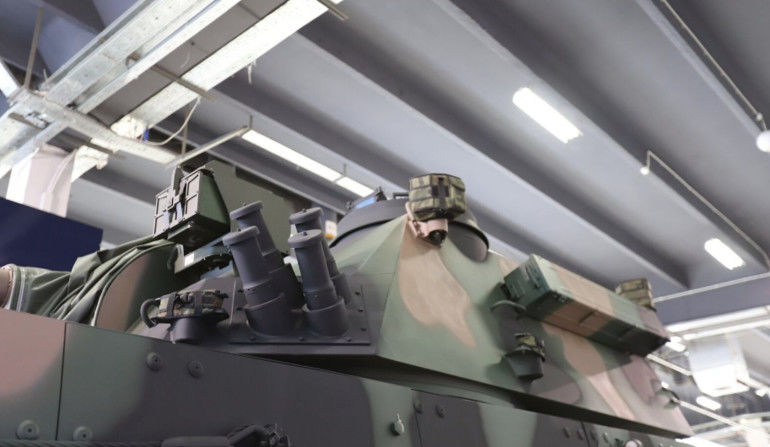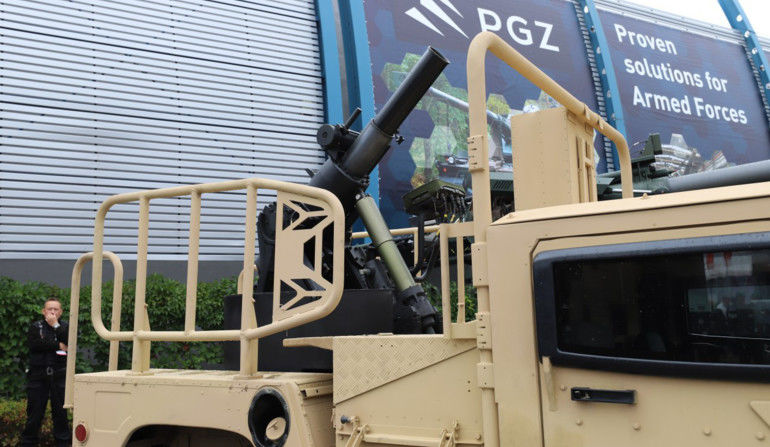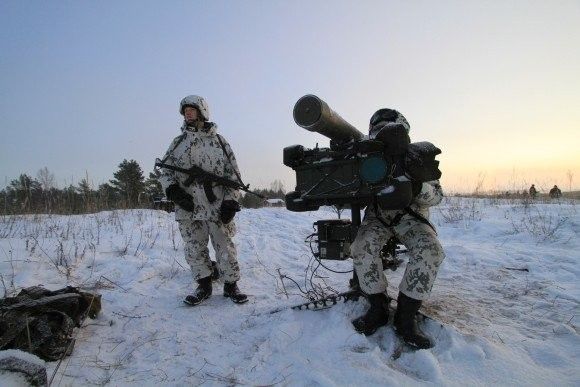HSW Presents IFVs and Artillery in Kielce
HSW S.A. company is showcasing a model of the Borsuk new amphibious IFV, along with the integrated armament - the remote control turret system fitted with a 30 mm cannon and spike ATGM.
The HSW S.A.’s offer showcased during this year’s edition of the Salon, features two highlights. The first one is seen in the fact that since a few months the Polish Armed Forces have been using two modern artillery systems that were being developed by the company during the recent years. Both the 120 mm self-propelled automatic Rak mortar, as well as the Regina self-propelled howitzer are already being used by the relevant units. Equipment for further “fire modules” is being series manufactured as we are writing the present article.
The second highlight is seen in the premiere of a new amphibious IFV which has been in development since the late 2014, within the framework of the Borsuk programme pursued by a consortium led by the HSW S.A. company. NPBWP (Nowy Pływający Bojowy Wóz Piechoty - New Amphibious IFV) model is being presented with a prototype example of the ZSSW-30 remote control turret module, designed for the Polish Ministry of Defence, also by HSW S.A. The turret is to be used both in case of Borsuk, as well as with the Rosomak APC. The turret itself was already presented during the MSPO salon during the recent years, however never has it been installed on an IFV.
ZSSW-30 has been designed as a hunter-killer solution, the purpose of which is to act against, destroy or neutralize, in a variety of weather conditions, at night and during the day, light and heavily armoured targets and other enemy assets, including the infrastructure. The turret also has a purpose of providing support for the own forces during combat. 30 mm automatic cannon with twin ammunition feed is the primary armament within the module, it is coupled with a 7.62 mm machine gun and twin-launcher for the Spike ATGM.

The turret has also been fitted with daytime/night targeting system in a stabilized housing, it features a laser warning receiver sensor system and 81 mm smoke grenade launchers.
The amphibious IFV integrated with the turret is a result of work performed on the basis of an agreement concluded with the National Centre for Research and Development, within the framework of the 5/2014 competition. The vehicle is to protect its crew and carried troops from small arms fire and anti-tank grenades, mines and IEDs. It is to have amphibious capabilities, it is also expected to be highly maneuverable and to be able to conduct operations in a variety of terrain and weather conditions. The vehicle should also be easy to transport. The model presented has been created out of the target armoured materials that are to be used in the final vehicles. It is going to be used to conduct handling tests, before the first actual prototype is created - this is planned to happen in 2018.
Fully autonomous turret system of the well known Rak self-propelled automatic 120 mm mortar has also been presented on a variety of vehicles, as well as on a stabilized platform destined to be used on vessels. Within the production programme pursued by HSW, the Rak mortar is manufactured in two variants - wheeled one (SM120K) and tracked one (SM120G). The turret with a crew of two is destined to be used for attacking the targets indirectly, semi-directly and directly.

Specialized rounds are used to provide light- and smoke support for the operational activities, i.e. target designation, creating perimeters, lighting up the areas, covering the units and camouflaging the maneuvers conducted by own forces. The vehicle features standard equipment, such as an integrated C4I and fire control system, based upon the ZSDiKO Topaz suite, along with a display of the tactical situation for the commander on a digital map, and a targeting device with a laser range-finder for conducting direct fire.
The turret may be coupled together with external C4I reconnaissance, command and fire control systems. It features the TALIN 5000 INS system coupled with GPS SASSM and odometer within the chassis and a ballistic computer. The weapon mount allows for conducting fire within 360 degrees range azimuth-wise and within a range between -3º to +80º elevation-wise. Combat readiness is attained in 30 seconds, the vehicle may leave the firing position in 15 seconds, following the last shot. The turret features the MRSI function and offers a rate of fire between 6 and 8 rounds per minute. The rounds may be fired directly and in a conventional manner, at distances of up to 10 thousand meters.
Presentation of another 120 mm self-propelled mortar at the HSW S.A.’s stand a was a surprise though. Here we are referring to the Elbit SPEAR system. HSW has been working together with the Elbit company within the framework of the Kryl sph programme. The mortar, based on a light vehicle, is yet another, alongside the 105 LG Mk III Nexter cannon (with HSW involved in the manufacturing efforts), offer dedicated for the WOT (Territorial Defence) component of the Polish Army.

Kryl self propelled 155 mm wheeled howitzer is yet another product, developed in collaboration with the National Centre for Research and Development. Its prototype has bee presented with the newly introduced changes, that are a result of the latest tests. Kryl self-propelled howitzer’s purpose is to destroy rocket and missile systems, artillery, SAMs, command positions, communication nodes, fortifications, mechanized and motorized units and other critical assets deep behind the enemy lines. The howitzer features an L52 barrel, allowing the system to attain a range between 5 and 40 kilometres.

Kryl may fire rounds at a rate of 6 per minute in intensive scenarios, or 2 per minute in continuous, sustainable scenarios, or with the use of MRSI system (at least 3 rounds), within elevation range from -2º to +70º and 50 degrees azimuthally. The time required to reach readiness to conduct fire after movement and time from the last shot to the vehicle leaving the position is said to be below 60 seconds.
The howitzer carries 18 rounds (rounds and propelling charges). Its autonomous or unit-based operation is ensured by a fire control system featuring a ballistic and artillery computers, displays for the gunner and the commander and TALIN 5000 INS. The vehicle also uses a muzzle velocity MVRS 700 SCD radar and digital radio and FONET intercom systems.








